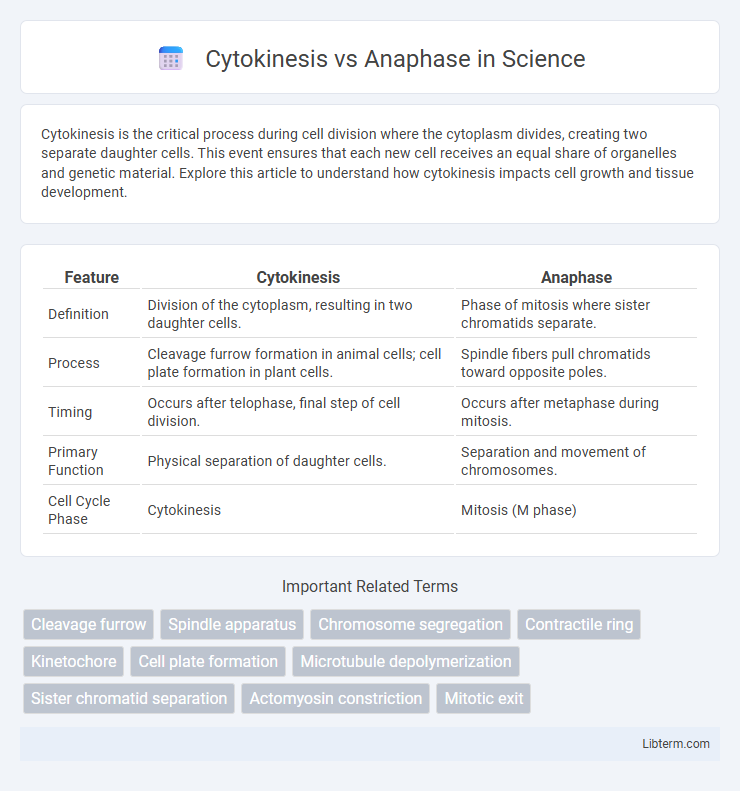Cytokinesis is the critical process during cell division where the cytoplasm divides, creating two separate daughter cells. This event ensures that each new cell receives an equal share of organelles and genetic material. Explore this article to understand how cytokinesis impacts cell growth and tissue development.
Table of Comparison
| Feature | Cytokinesis | Anaphase |
|---|---|---|
| Definition | Division of the cytoplasm, resulting in two daughter cells. | Phase of mitosis where sister chromatids separate. |
| Process | Cleavage furrow formation in animal cells; cell plate formation in plant cells. | Spindle fibers pull chromatids toward opposite poles. |
| Timing | Occurs after telophase, final step of cell division. | Occurs after metaphase during mitosis. |
| Primary Function | Physical separation of daughter cells. | Separation and movement of chromosomes. |
| Cell Cycle Phase | Cytokinesis | Mitosis (M phase) |
Introduction to Cell Division
Cytokinesis and anaphase are critical stages in the process of cell division, specifically during mitosis. Anaphase is characterized by the separation of sister chromatids to opposite poles of the cell, ensuring accurate genetic distribution. Cytokinesis follows by physically dividing the cytoplasm, resulting in the formation of two distinct daughter cells, each containing a complete set of chromosomes.
Overview of Mitosis and Its Stages
Mitosis is a crucial process of cell division consisting of distinct stages: prophase, metaphase, anaphase, and telophase, followed by cytokinesis. Anaphase involves the separation of sister chromatids toward opposite poles, ensuring equal genetic distribution. Cytokinesis, occurring after telophase, divides the cytoplasm, resulting in two physically separate daughter cells.
Anaphase: Definition and Key Processes
Anaphase is a critical stage of mitosis where sister chromatids separate and move toward opposite spindle poles, ensuring equal genetic material distribution. Key processes in anaphase include the shortening of microtubules attached to kinetochores, driven by motor proteins like dynein, and the physical pulling apart of chromatids. This phase is essential for genomic stability and precedes cytokinesis, where the cell divides its cytoplasm to form two distinct daughter cells.
Cytokinesis: Definition and Key Processes
Cytokinesis is the final stage of cell division, where the cytoplasm divides, creating two distinct daughter cells. It involves the formation of a contractile ring composed of actin and myosin filaments, which pinches the cell membrane inward to complete cellular separation. Unlike anaphase, which focuses on chromosome segregation, cytokinesis ensures physical division and distribution of cellular organelles into each daughter cell.
Molecular Mechanisms in Anaphase
Anaphase is characterized by the activation of the anaphase-promoting complex/cyclosome (APC/C), which triggers the ubiquitination and degradation of securin, releasing separase to cleave cohesin complexes and allowing sister chromatids to segregate. The spindle assembly checkpoint ensures that kinetochore-microtubule attachments are properly established before APC/C activation, preventing premature anaphase onset. Cytokinesis occurs post-anaphase, driven by the formation of the contractile ring composed of actin and myosin II, orchestrated by RhoA GTPase signaling, leading to the physical separation of daughter cells.
Molecular Mechanisms in Cytokinesis
Cytokinesis is driven by the formation and constriction of the actomyosin contractile ring, primarily regulated by RhoA GTPase, which orchestrates the assembly of actin filaments and myosin II motors at the cleavage furrow. Key molecular players include the centralspindlin complex, which recruits ECT2, a guanine nucleotide exchange factor that activates RhoA, initiating contractile ring formation. This process contrasts with anaphase, where the primary molecular events involve the separation of sister chromatids facilitated by the anaphase-promoting complex/cyclosome (APC/C) and microtubule dynamics, setting the stage for subsequent cytokinesis.
Timing: When Anaphase and Cytokinesis Occur
Anaphase occurs during the mitotic phase of the cell cycle, specifically following metaphase, and is characterized by the separation of sister chromatids moving toward opposite poles of the cell. Cytokinesis takes place after anaphase, during the final stage of cell division, where the cytoplasm divides, resulting in the formation of two distinct daughter cells. The timing difference ensures chromosome segregation completes before the physical separation of the cell body.
Visual and Structural Differences
Cytokinesis involves the physical splitting of the cytoplasm into two daughter cells, characterized by the formation of a cleavage furrow in animal cells or a cell plate in plant cells, visually marking the end of cell division. Anaphase is a stage within mitosis where sister chromatids are pulled apart toward opposite spindle poles, showing distinct chromosome movement along microtubules. Structurally, anaphase features condensed chromosomes moving within an intact cell, while cytokinesis presents the actual division of cytoplasmic content, resulting in two separate cells.
Biological Significance of Anaphase vs Cytokinesis
Anaphase is biologically significant as it ensures the accurate segregation of sister chromatids to opposite poles, which is critical for maintaining genetic stability during cell division. Cytokinesis, on the other hand, finalizes cell division by physically separating the cytoplasm into two daughter cells, enabling cellular proliferation and tissue growth. Both processes are essential for organismal development, with anaphase focusing on genetic fidelity and cytokinesis on cellular partitioning.
Summary Comparison: Anaphase vs Cytokinesis
Anaphase is the stage in mitosis where sister chromatids are pulled apart toward opposite poles of the cell, ensuring equal genetic distribution. Cytokinesis follows telophase and involves the division of the cytoplasm into two daughter cells, completing cell division. While anaphase focuses on chromosomal segregation, cytokinesis finalizes the physical separation of the two new cells.
Cytokinesis Infographic

 libterm.com
libterm.com